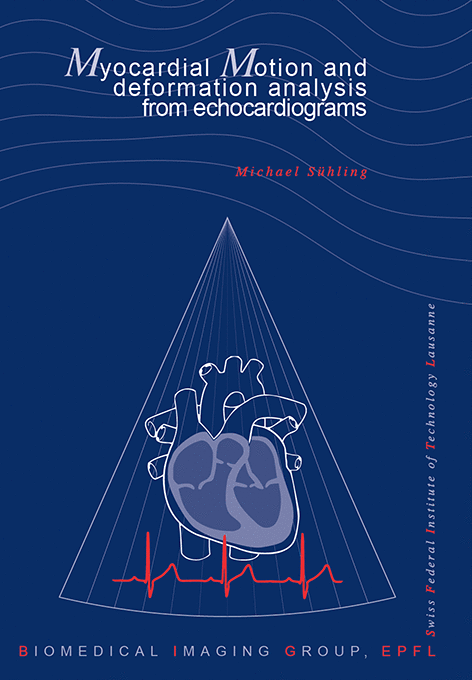Myocardial Motion and Deformation Analysis from Echocardiograms
M. Sühling
École polytechnique fédérale de Lausanne, EPFL Thesis no. 3049 (2004), 181 p., July 16, 2004.
Echocardiography is a widely used imaging technique to examine myocardial function in patients with known or suspected heart disease. The analysis of ventricular wall motion and deformation, in particular, allows to assess the extent of myocardial ischemia and infarction. In clinical practice, the analysis mainly relies on visual inspection or manual measurements by experienced cardiologists. Manual methods are tedious and time-consuming, and visual assessment leads to qualitative and subjective diagnoses that suffer from considerable inter- and intraobserver variability. Automating the analysis of echocardiographic images is therefore highly desirable but also challenging because of the low image quality and the high amount of speckle noise. In this thesis, we propose a framework for robust and quantitative analysis of echocardiographic sequences. We make the following key contributions:
Motion and Deformation Analysis—We propose a novel optical-flow-based algorithm to estimate ventricular wall motion from B-mode echocardiograms. To account for typical heart motions such as contraction/expansion and shear, we use a local affine model for the velocity in space and time. An attractive feature of the affine motion model is that it gives also access to local strain rate parameters that describe local myocardial deformation such as wall thickening. The motion parameters are estimated in the least-squares sense within a sliding spatio-temporal B-spline window. The estimation of large motions is made possible through the use of a coarse-to-fine multi-scale strategy, which also adds robustness to the method.
Computational Efficiency—We introduce the notion of multiresolution moment filters, a novel filtering scheme to compute local weighted geometric moments efficiently at dyadic scales by using a wavelet-like algorithm. Beyond their application in motion analysis, we demonstrate their usefulness for image denoising and feature extraction.
Multi-Modality—We extend the proposed motion analysis algorithm by integrating directional, Doppler-based velocity measurements. The exploitation of two ultrasound modalities, i.e., B-mode and tissue Doppler, renders the method more accurate and robust.
Visualization—We display diagnostically meaningful motion data inside a user-defined region of interest that is tracked in time. Myocardial inward and outward motion is visualized by color coding the radial motion component with respect to the ventricular center. Two-dimensional strain rate information is superimposed in the form of deforming ellipses. The display allows a more intuitive and simplified identification of regions with abnormal motion patterns.
Validation—The proposed method is validated on 1) synthetic data, 2) real ultrasound phantom data, and 3) clinical echocardiograms. A large-scale validation study that includes 114 patients confirms its ability to detect and quantify wall motion abnormalities.

@PHDTHESIS(http://bigwww.epfl.ch/publications/suehling0404.html,
AUTHOR="S{\"{u}}hling, M.",
TITLE="Myocardial Motion and Deformation Analysis from Echocardiograms",
SCHOOL="{\'{E}}cole polytechnique f{\'{e}}d{\'{e}}rale de {L}ausanne
({EPFL})",
YEAR="2004",
type="{EPFL} Thesis no.\ 3049 (2004), 181 p.",
address="",
month="July 16,",
note="")